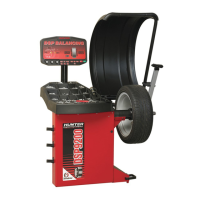2. BALANCING OVERVIEW
2.1 Balancing Modes
Static Balance
As the word static implies, the tire will be balanced when at rest. For example, if an
unmoving assembly was centered on a cone and was balanced, it would be statically
balanced. A “bubble balancer” is designed to statically balance a tire/wheel
assembly.
IMBALANCE
FORCE
FRONT VIEW
STATIC IMBALANCE
CUPPING
Static imbalance is where there is one amount of weight located in the center of the
tire/wheel assembly causing an imbalance. As the weight rotates, centrifugal forces
are created causing the wheel to lift as the weight reaches top dead center. This
lifting motion causes the tire/wheel assembly to move “up and down” creating a
bounce to be felt. This static imbalance condition is evident by a “jiggle” or up-down
movement of the steering wheel. These vibrations may also be apparent in the body,
with or without steering wheel shake.
A statically imbalanced tire driven for an extended period may cause “cupping” in the
tire’s tread, create vibration, and adversely effect handling.
Static balancing alone is a seldom-recommended procedure that balances the
assembly using only a single weight plane. For example, a single weight is commonly
placed on the inner clip weight position for cosmetic purposes. This is not a
recommended practice and usually insures the assembly is not properly dynamically
balanced. The assembly may then experience side-to-side imbalance while in
motion, causing a shimmy condition and objectionable vibration.
DSP9200 Series Balancer Operation Instructions 2. Balancing Overview
13

